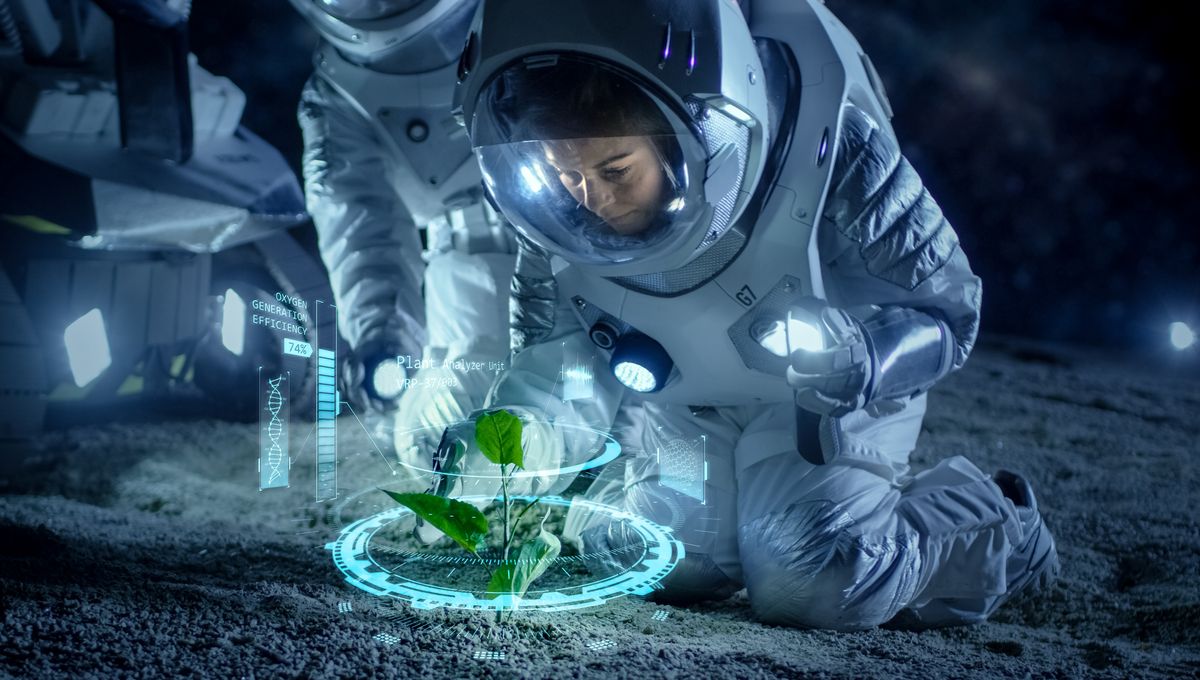
Chickpeas have been grown on the Moon. Well, not on the Moon exactly – not even in the sense that one couple had sex “on the Moon” – but they have been grown using simulated lunar dust, replicating samples brought back by the Apollo missions. Assuming this work can be extended to other plant species, it’s a step towards a future in which lunar bases are partially self-sufficient, although those wishing to apply might be advised to get used to a vegan diet.
The capacity to grow their own food is an essential requirement of future space colonies. Even Antarctic bases now grow some fresh fruit and vegetables for morale purposes – but in their case, it’s usually cheaper to ship food in. If that’s the case for human settlements beyond the Earth, then our prospects for expansion as a species are grim indeed. Things will not be much better if we need to take the soil with us to farm, rather than finding at least some on location.
The Moon does not have soil as we think of it, but it has regolith, the surface’s loose dust and bits of rock, which will need to be the primary medium in which future colonies grow their food. The Apollo missions returned regolith samples from their landing sites, along with larger chunks of rock. In a preprint yet to pass peer review, two agricultural scientists claim Earthly fungi and worm castings are the key to growing plants in this.
Lunar regolith could pose two obstacles to space agriculture: what it contains, and what it lacks. The second should be easier to deal with; when vital nutrients are in short supply, we can bring supplements from Earth, but toxins pose more of a challenge.
Jessica Atkin of Texas A&M University and Brown University PhD student Sara Oliveira Pedro dos Santos say they have dealt with both. They used arbuscular mycorrhizal fungi to capture the heavy metals in lunar soils and prevent them from being taken up by plants. For nutrients, the pair turned to vermicompost; that is the product of a worm farm. They note the worms can be fed not only waste food but also used clothing and hygiene items.
Access to samples from the Apollo missions is improving as NASA no longer fears replenishment may be decades away. Nevertheless, testing multiple scenarios would have exceeded availability. Instead, Atkin and dos Santos replicated Apollo samples as closely as possible and created pots with between 25 and 100 percent imitation lunar regolith mixed with worm droppings. Half were inoculated with fungi, while the rest had to fend for themselves.
Plants without fungal protection started to die by week 10. Even with inoculation, the plants in the 100 percent lunar soil only lasted two weeks longer. However, those in up to 75 percent lunar soils did better, flowering despite signs of chlorophyll deficiency. Further data is promised as the experiment goes on.
The pair chose chickpeas because the products are high in protein and micronutrients, and as legumes they have a symbiotic relationship with the fungi, offering space on its roots for the symbiont to grow.
Atkin and dos Santos are not the first to try growing plants in lunar soil. They note that research using the model plant Arabidopsis thaliana got seeds to germinate, but the seedlings grew more slowly than they should have and showed signs of severe stress.
One thing this experiment did not address is the effects of low gravity or high radiation. However, the limited data available from Chang’e 4’s efforts to grow a plant in Earth soil on the lunar surface suggests lunar gravity may even assist plant growth.
There’s still a long way to go, however. Even if the plants produce chickpeas, being the first to try them might be a little like the job of a Roman Emperor’s food taster. “They will need to be tested for heavy metal concentrations, and we’re going to do that,” Atkin told New Scientist. Nevertheless, she has hope, adding; “Even if the first few generations of chickpeas are not edible, the bioremediation process could take those toxins out of the soil over time.” Being a space colonist will require patience, and not just when it comes to taking off.
The preprint is hosted on biorxiv.
Source Link: Chickpeas Grown In Replica Lunar Soil With Help From Worms And Fungus